Daimler has published detailed information regarding the new diesel and petrol engines powering the 2010 Mercedes S Class.
The first is powering the ‘world’s most economical luxury saloon’ which is the 2010 Mercedes S 250 CDI BlueEFFICIENCY. Delivering 204 HP (150 kW) the 2010 Mercedes S 250 CDI BlueEFFICIENCY consumes just 5.7-litres of fuel per 100 Km and has CO2 emissions of 149 g/Km.
The second engine is the new V6 diesel powering the 2010 Mercedes S 350 BlueTEC which packs 258 HP (190 kW) and thanks to which combined fuel consumption is of 6.8-litres per 100 Km, while CO2 emissions are 177 grams per Km.
The third unit is the 3.5-litre V6 of the 2010 Mercedes S 350
BlueEFFICIENCY. In this case power levels are at 306 HP (225 kW), and covering 100 Km requires 7.6-litres of fuel. CO2 emissions are of 177 g/Km, or 179 g/Km in the longwheelbase version.
Finally the 4th new engine with improved consumption and emission figures is a 4.7-litre V8 biturbo plant that goes on the 2010 Mercedes S 500 BlueEFFICIENCY. With 435 HP (320 kW) under its bonnet, the S 500 BlueEFFICIENCY covers 100 Km on 9.3-litres of premium petrol, while CO2 figures correspond to 219 g/Km.
Daimler press release :
With a total of four new diesel and petrol engines, the Mercedes-Benz S-Class defines the efficiency standard in its segment. The accolade of "the world’s most economical luxury saloon" goes to the new S 250 CDI BlueEFFICIENCY. This high-tech turbodiesel is the first four-cylinder engine in the almost 60-year success story of the S-Class. Developing an output of 150 kW (204 hp), the S 250 CDI BlueEFFICIENCY achieves a fuel consumption of just 5.7 litres per 100 kilometres (NEDC), corresponding to CO2 emissions of 149 grams per kilometre. The likewise new V6 diesel in the S 350 BlueTEC delivers 190 kW (258 hp) and has a combined consumption of 6.8 litres per 100 kilometres (177 g CO2/km). Thanks to AdBlue® emission control, it is one of the world’s cleanest diesel engines. With 225 kW (306 hp) in the S 350 BlueEFFICIENCY and 320 kW (435 hp) in the S 500 BlueEFFICIENCY, the new BlueDIRECT engine generation is now entering the lists in the form of V6 and V8 petrol variants.
"The new highly efficient petrol and diesel
engines in the S-Class demonstrate that our customers are also able to
drive a luxury class car with a clear conscience," says Dr. Thomas
Weber, the member of the Daimler AG Executive Board responsible for
corporate research and development at Mercedes-Benz Cars. "More than
ever before, the luxury saloon combines the leadership claim of
Mercedes-Benz with respect to efficient drive systems with the classic
brand strengths in the realms of design, safety, comfort and
effortlessly superior performance".
All the diesel and petrol engines have direct injection
Mercedes-Benz achieves the considerable reduction
in fuel consumption and improvement in efficiency with an intelligent
combination of technical innovations that take effect throughout the
entire powertrain: in addition to direct injection in the diesel
engines, as well as in the new V6 and V8 BlueDIRECT petrol engines,
these include the extensively revised, high-efficiency 7G-TRONIC PLUS
7-speed automatic transmission and the ECO start/stop function. This
high-tech package is supplemented with other specific BlueEFFICIENCY
measures such as the load-controlled oil pump and tyres with lower
rolling resistance.
The four-cylinder diesel in the S 250 CDI BlueEFFICIENCY
is equipped with latest-generation common-rail direct injection. The
high rail pressure of 2000 bar enables output and torque figures at the
level of a six-cylinder diesel to be achieved.
In the S 350 BlueEFFICIENCY and S 500 BlueEFFICIENCY,
the newly developed BlueDIRECT technology package ensures a lower fuel
consumption together with increased power. The key factor is
third-generation spray-guided direct petrol injection with multiple
injection and multi-spark ignition. With the innovative V6 and V8 petrol
units, Mercedes-Benz is founding a family of engines with a wide range
of displacements and outputs. This is based on a flexible, modular
concept that allows the integration of turbochargers, and combination
with 4MATIC all-wheel drive as well as hybrid modules.
Fuel economy: ECO start/stop function
The excellent consumption and emission figures are also due to the new ECO start/stop function.
This is standard equipment in the S 250 CDI BlueEFFICIENCY as well as
the petrol-powered S 350 BlueEFFICIENCY and S 500 BlueEFFICIENCY models.
The ECO start/stop function switches the engine off as soon as the
vehicle stops – for example at traffic lights – and the driver keeps the
brake pedal depressed after coming to a halt. The engine restarts
immediately when the driver takes his foot from the brake pedal.
The ECO start/stop function will not switch the
engine off if e.g. the desired interior temperature has yet to be
reached, if the driver has switched off the system or if drive modes "S"
or "M" are active. An intelligent control system ensures that all
functions and comfort systems otherwise remain in operation during the
stop phase.
S 250 CDI BlueEFFICEINCY: first 5 litres/100 km car in the luxury segment
With the new S 250 CDI BlueEFFICIENCY, Mercedes-Benz is now launching the world’s most fuel-efficient luxury saloon.
The first four-cylinder engine in the more than 60-year success story
of the S-Class attains a fuel consumption of just 5.7 litres per 100
kilometres, corresponding to CO2 emissions of 149 grammes per
kilometre. This makes the new S 250 CDI BlueEFFICIENCY the first car in
the luxury segment to run on under 6 litres of fuel per 100 km, and the
first vehicle in its class to attain CO2 emissions below the 150 gramme
mark. With a peak power output of 150 kW (204 hp) and
maximum torque of 500 Newton metres, the four-cylinder CDI guarantees
the superior performance which is a hallmark of the S-Class. It
accelerates the large saloon from 0 to 100 km/h in 8.2 seconds, and
attains a top speed of 240 km/h.
The 2.2-litre CDI engine already delivers its
maximum torque of 500 Nm at 1600 rpm. The high torque at low engine
speeds is a result of two-stage turbocharging. This
technology, which is employed in a series-production passenger car
diesel engine for the first time in the C and E-Class, is predominantly
responsible for the high output at the level of a six-cylinder power
unit.
The compact module for the two-stage turbocharger consists of a small high-pressure (HP) turbocharger and a large low-pressure (LP) turbocharger.
These are connected in series, and each has a turbine and a compressor
driven by this turbine. The HP turbine is located directly at the
exhaust manifold and initially allows exhaust gas to flow through it; it
then rotates at up to 215,000 revolutions per minute. The HP turbine
housing features an integral bypass duct, which can be opened or closed
by means of a charge-pressure control flap triggered by a vacuum cell.
If the flap is closed, the whole exhaust stream flows through the HP
turbine, so that the exhaust-gas energy is available solely for the HP
turbine drive. This means that the optimum charge pressure can be built
up at low engine revs.
Improved cylinder charging even at low rpm
The two compressors are likewise connected in
series, and are in addition connected to a bypass duct. The combustion
air from the air filter first flows through the low-pressure compressor,
where it is compressed as a function of the LP turbine’s output. This
pre-compressed air then passes into the high-pressure compressor, which
is coupled to the HP turbine, where it undergoes further compression.
The result is a genuine two-stage turbocharging process. The major
advantage of this sophisticated, demand-related control of the
combustion air supply using two turbochargers is improved cylinder
charging, and therefore high torque even at low engine speeds. Fuel
consumption is also reduced. When the car is driven, this concept makes
itself felt by harmonious driving characteristics with no turbo-lag, a
favourable torque curve across the entire engine speed range, great
responsiveness and excellent performance.
Fourth-generation common rail technology
A further feature of the innovative and highly
efficient diesel engine is fourth-generation common rail direct
injection. The rail pressure of 2000 bar is essential for the delivery
of 150 kW (204 hp) of engine output and maximum torque of 500 Nm, while achieving low untreated emissions.
Dynamically controlled engine mounts dampen vibrations
To ensure hallmark S-Class comfort, dynamically controlled engine mounts
feature as an innovation in the new S 250 CDI BlueEFFICIENCY. The
rigidity and damping of these mounts alter according to engine speed,
load and vehicle speed, thus preventing the transmission of unwanted
vibrations and noise from the engine to the body.
Key figures for the four-cylinder diesel engine
| Cylinder number/arrangement | 4/in-line |
| Displacement (cc) | 2143 |
| Bore (mm) | 83 |
| Stroke (mm) | 99 |
| Compression ratio | 16.2 : 1 |
| Output (kW at rpm) | 150 at 4200 rpm |
| Torque (Nm at rpm) | 500 at 1600-1800 rpm |
S 350 BlueTEC: highly efficient, clean, powerful
The second new diesel model in the S-Class is the S 350 BlueTEC. Its V6 develops an output of 190 kW (258 hp) from a displacement of 2987 cc. This is ten percent more than the previous model, which delivered 173 kW (235 hp). The torque of the V6 diesel has increased by 15 percent from 540 to 620 newton metres. Despite much improved performance, with a combined consumption of 6.8 litres
of diesel fuel per 100 kilometres the S 350 BlueTEC betters its
predecessor by 0.8 litres or eleven percent. CO2 emissions have likewise
fallen by eleven percent, from 199 to 177 grams per kilometre. The
highly efficient V6 diesel gives the luxury saloon effortlessly superior
performance: it sprints from zero to 100 km/h in 7.1 seconds and has a
top speed of 250 km/h.
Moreover, the S 350 BlueTEC ranks among the
world’s cleanest diesel models: BlueTEC is a technology developed by
Mercedes-Benz to reduce emissions from diesel vehicles, in particular
nitrogen oxides. To this end AdBlue®, an aqueous urea solution, is
injected into the exhaust flow. This releases ammonia, which converts up
to 80 percent of nitrogen oxides into harmless nitrogen and water in
the downstream SCR (Selective Catalytic Reduction) catalytic converter.
As a result, the S 350 BlueTEC already complies with the emission levels
which are planned for 2014 with the introduction of the EU6 standard.
The AdBlue® tank is installed under the boot floor and has a capacity of
25.7 litres. The supply is replenished at the regular maintenance
intervals, every 25,000 kilometres.
Key figures for the new V6 diesel engine
| Cylinder arrangement/number | V6 |
| Displacement (cc) | 2987 |
| Bore (mm) | 83 |
| Stroke (mm) | 92 |
| Compression ratio | 15.5:1 |
| Output (kW at rpm) | 190 at 3600 |
| Torque (Nm at rpm) | 620 at 1600-2400 rpm |
BlueDIRECT technology makes V6 and V8 engines fit for the future
With the two BlueDIRECT power plants of the S 350
BlueEFFICIENCY and S 500 BlueEFFICIENCY, Mercedes-Benz is once again
raising the bar when it comes to efficiency in the luxury saloon
segment. They are representatives of a new generation of BlueDIRECT V6
and V8 engines. With its new generation V-engines, Mercedes-Benz is
clearly demonstrating that with concerted further development, internal
combustion engines still have a great deal of potential, and that V6 and
V8 engines with their high level of refinement also have a future.
Centrepiece of the BlueDIRECT technology package is the improved third-generation direct petrol injection
with spray-guided combustion and piezo injectors. In combination with
multi-spark ignition it taps further possibilities for improving
consumption – in the V8 unit through a further developed homogeneous
combustion process ("homogeneous split"); in the V6
engine through a new stratified combustion method with a much larger
useful engine characteristic map and lean-burn combustion for optimum
consumption ("homogeneous stratified mode"). As the
name indicates, the HOS method is a combination of homogeneous-lean and
conventional stratified combustion. The first injection takes place
during the intake stroke so that a homogeneous base mixture is formed.
The "stratified" injection proper takes place during the compression
stroke prior to ignition, as map-controlled single or double injection.
Multi-spark ignition: best possible ignition to suit requirements
The third-generation direct injection system also
features rapid multi-spark ignition (MSI). Following the first spark
discharge and a brief combustion period, the coil is rapidly recharged
and a further spark is discharged. The MSI system enables up to four sparks to be discharged in rapid succession within one millisecond,
creating a plasma with a larger spatial expansion than conventional
ignition. Controlling this rapid multi-spark ignition enables both the
time lapse before the next spark and the combustion duration for the
relevant operating point to be optimally adjusted. This provides scope
for optimising the centre of combustion and improving residual gas
compatibility, especially during stratified charge operation. Fuel
consumption can be reduced by roughly two percent in this way.
Depending on the driving cycle, fuel savings of
up to four percent are possible alone by the use of piezo-electric
injection technology in combination with multi-spark ignition.
S 350 BlueEFFICIENCY: up to 24 percent lower consumption
The ultra-modern 3.5-litre V6 engine of the S 350
BlueEFFICIENCY and S 350 4MATIC BlueEFFICIENCY is naturally aspirated,
but also suitable for the future use of a turbocharger thanks to the
modular design concept. The most striking change between the new V6 unit
and its predecessor is a reduction in the V-angle between the cylinder
banks from 90 degrees to 60 degrees. This enables the primary balancer
shaft to be omitted, and as a result the driver registers an outstanding
level of comfort.
The design highlights of the 3.5-litre V6 include
a completely new air intake and exhaust system in conjunction with a
variable resonance intake manifold and optimised inflow and outflow.
Result: with the same displacement, the output compared with the
previous 200 kW (272 hp) model is increased by 12.5 percent to 225 kW
(306 hp), while maximum torque has increased by 5.7 percent to 370
Newton metres (predecessor: 350 Nm) and now is available over a broad
engine speed range from 3500 to 5250 rpm.
In parallel with this substantial increase in
power, Mercedes engineers have achieved an even more impressive
reduction in fuel consumption. The predecessor’s NEDC consumption was
already good at 10.0 litres of premium petrol per 100 kilometres, but
has now been cut by almost a quarter. The new V6 petrol engine in the S
350 BlueEFFICIENCY is content with 7.6 litres per 100 kilometres. That
adds up to savings of 2.4 litres or 24 percent, and makes the S 350
BlueEFFICIENCY the most economical petrol model in the luxury class. CO2
emissions have also fallen by 24 percent – from 234 to 177 grams per
kilometre (short wheelbase) and by 23.5 percent to 179 grams per
kilometre (long wheelbase). The S 350 BlueEFFICIENCY combines excellent
consumption figures with dynamic performance, accelerating from
standstill to 100 km/h in 6.9 seconds. Top speed is 250 km/h
(electronically limited).
Key figures for the new V6 petrol engine
| Cylinder arrangement/number | V6 |
| Displacement (cc) | 3498 |
| Bore (mm) | 92.9 |
| Stroke (mm) | 86 |
| Compression ratio | 12.2:1 |
| Output (kW at rpm) | 225 at 6500 |
| Torque (Nm at rpm) | 370 at 3500-5250 rpm |
S 500 BlueEFFICIENCY: more powerful, more economical, more efficient
The new V8 biturbo engine in the S 500 BlueEFFICIENCY and S 500 4MATIC BlueEFFICIENCY generates 320 kW (435 hp) with 15 percent less displacement (4663 instead of 5461 cc), and therefore around twelve percent more output than its 285 kW (388 hp) predecessor. Torque has risen from 530 to 700 newton metres – an increase of 32 percent.
Despite a considerable increase in power of 35 kW
(47 hp), Mercedes developers have been able to reduce the combined fuel
consumption of the S 500 BlueEFFICIENCY significantly. At 9.3 litres of
premium petrol per 100 kilometres, this is 15.5 percent (short
wheelbase) and 16 percent (long wheelbase) below the figure for the
preceding model. An outstanding figure in the luxury class, this
corresponds to CO2 emissions of 219 grams per kilometre. The excellent
efficiency goes hand in hand with superior performance: the S 500
BlueEFFICIENCY sprints from zero to 100 km/h in impressive 5.0 seconds.
Top speed is 250 km/h (electronically limited). The increase in output
and torque despite the reduced displacement is mainly due to the use of
two turbochargers – one for each bank of cylinders. These force the
intake air into the eight combustion chambers at a pressure of up to
0.9. The turbochargers are configured to provide a high torque at low
engine speeds, and an outstanding 600 newton metres are already
available between 1600 and 4750 rpm.
Key figures for the new V8 biturbo engine
| Cylinder arrangement/number | V8 |
| Displacement (cc) | 4663 |
| Bore (mm) | 92.9 |
| Stroke (mm) | 86 |
| Compression ratio | 10.5:1 |
| Output (kW at rpm) | 320 at 5250 |
| Torque (Nm at rpm) | 700 at 1800-3500 rpm |
The S 600, with its 380 kW
(517 hp) 12-cylinder biturbo engine remains the top-of-the-line model:
it accelerates the luxury saloon from a standstill to 100 km/h in
impressive 4.6 seconds, and now also complies with the Euro 5 emission
standard.
More efficiency thanks to demand-controlled ancillary units
In order to improve efficiency, Mercedes-Benz
developers have also reduced the power consumption of the ancillary
units for the new petrol and diesel engines. One of these is a newly
developed, controlled oil pump. This operates at two pressure levels. At
low engine speeds and loads the pump runs at a low pressure. The
high-pressure stage is activated at the upper load and engine speed
levels. Thanks to this innovative control concept, the lubrication and
cooling points of the engine can be supplied with significantly lower
drive energy than would be possible with an uncontrolled pump. In this
way, the developers have particularly managed to lower fuel consumption
in driving modes requiring less power, for example in urban traffic.
Another special feature is the switchable water pump.
To enable faster engine warm-up, the pump is not activated until the
optimum operating temperature is reached. This also contributes to the
reduction in fuel consumption.
In the S 350 BlueEFFICIENCY and S 500 BlueEFFICIENCY, there is also intelligent generator management with braking energy recuperation.
Designed for maximum efficiency: the new 7G-TRONIC PLUS
All four new engines are combined with the new
7G-TRONIC PLUS 7-speed automatic transmission, which brings a further
reduction in torque converter slip and optimised efficiency.
A central role is played by the new torsion damper, which eliminates
torsional eccentricities and vibrations in the transmission. The lower
the rpm and the lower the number of cylinders, the more severe these can
be. This results in a conflict of aims between comfort and
fuel-efficient operation. Mercedes-Benz developers resolved this by
using a so-called twin-turbine damper, which is also fitted with a
centrifugal pendulum. Depending on the rpm, this moves the centre of
mass and allows comfortable operation even in the most economical
operating range.
The optimised damping allows a marked reduction
in the slip of the torque converter lockup clutch even under low loads.
In the fuel-efficient ECO transmission mode, this has enabled engine
speeds to be lowered without compromising signature S-Class comfort. In
addition, the optimised damping of rotational irregularities and
vibrations in the transmission allows an even faster response to driver
commands via the accelerator pedal.
The S 350 BlueTEC is already in the showrooms of
Mercedes-Benz own-retail outlets and dealerships. The S-Class with the
new BlueDIRECT petrol engines and the S 250 CDI BlueEFFICIENCY can be ordered with immediate effect.
| S 250 CDI BlueEFFICIENCY | Euro 71,876* |
| S 350 BlueTEC | Euro 76,279* |
| S 350 BlueEFFICIENCY | Euro 78,718* |
| S 500 BlueEFFICIENCY | Euro 99,186* |
| S 600 | Euro 156,961 |
All prices include 19 % VAT.
* for short-wheelbase model; S600 standard as long wheelbase version

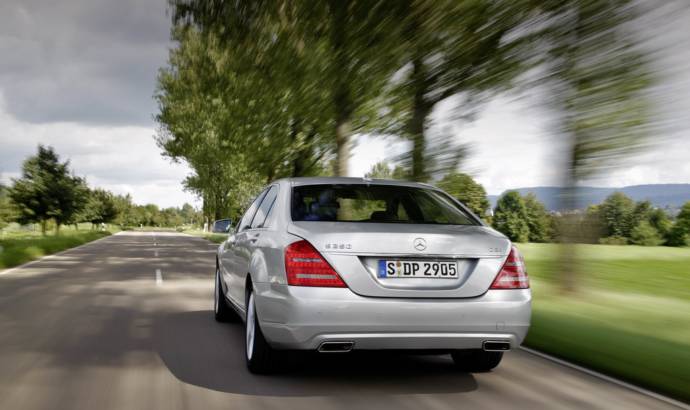
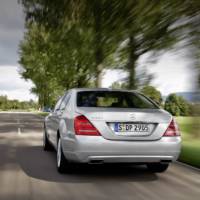
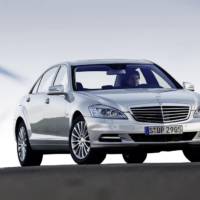
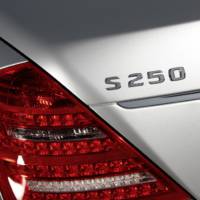
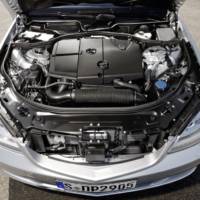
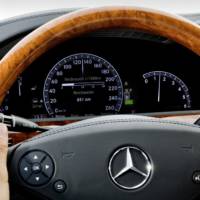
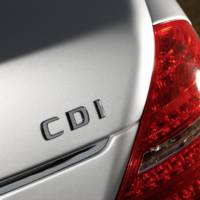
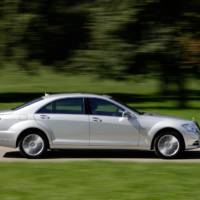
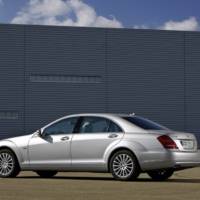
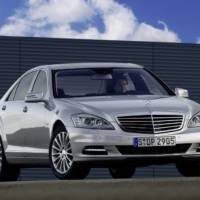
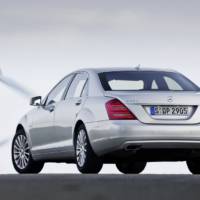
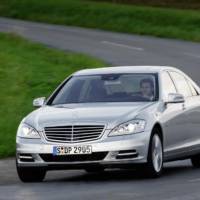
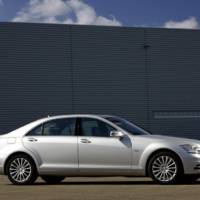
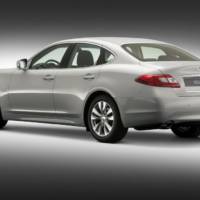
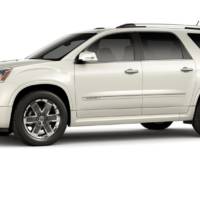
Oggi è di tendenza il downsizing in campo motoristico. E forse è una scelta pure intelligente, in un’epoca di crisi economica che lambisce un pò tutti. E il fenomeno interessa pure il settore del lusso, dove anche lì, se è possibile risparmiare qualcosa, perchè non approfittarne? In quest’ottica si inserisce la nuova Mercedes S 250 Cdi. Un buon 4 cilindri tecnologicamente valido e di cubatura relativamente ridotta pùò funzionare pure sotto una ammiraglia di alto livello come la Classe S. Avrà successo questa versione? Secondo me, premesso che la tecnologia e le buone prestazioni ci sono, tutto dipenderà dal prezzo di vendita. Solo se il risparmio rispetto alla versione di accesso a 6 cilindri di 3.000 cc diesel sarà considerevole, una tale motorizzazione “ridotta” avrà senso. Altrimenti l’acquirente preferirà la sicurezza della motorizzazione più grande e più esclusiva!
BUON NATALE e FELICE ANNO NUOVO 2011!!!